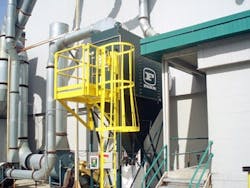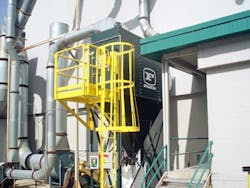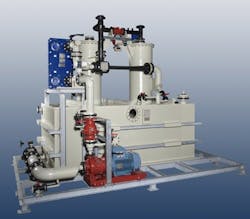Dust Removal Gets A Rethink
In line with their quest for more sustainable processes, chemical companies are re-evaluating how they select dust collection and removal technologies. They are demanding improved energy efficiency, easier maintenance, greater product recovery and enhanced operator safety. More and more, they also are focusing on total cost of ownership (TCO) rather than initial price — an approach that equipment suppliers say has even more benefits than initially might be expected.
"Sustainability is a fact of life now and the most important aspects of it for us are reducing energy consumption and increasing product life. There are several layers to this. For example, when it comes to reducing energy consumption both design and filter media are important. Better media allow for lower smaller pressure drops. They also improve cleanability. If you need less cleaning, you use less compressed air, which is another energy saving for customers," explains John Dauber, vice president of sales U.S.A. and Canada for Camfil Farr Air Pollution Control, Jonesboro, Ark.
Sustainability also includes disposal costs incurred by spent filters, the benefits of providing clean air from a process to the environment and the overall carbon footprint of a plant.
"We try to save customers money over the life of a piece of equipment to give them the best value and the TCO is a very big issue for us, especially in the U.S.," Dauber adds.
The only accurate way to determine which filter is the most sustainable and economic choice is to carry out a TCO calculation. This requires information on three different cost elements: energy, consumables, and maintenance and disposal. Each category involves a number of factors.
For example, for energy, it's important to know how many days per year the collection system operates, the volume of air required, electricity's kWh price and how much each hour of no production costs. For consumables, filter costs are important but the analysis also must consider the number of cartridges within a dust collector and the shipping cost per filter. Maintenance and disposal costs must include factors such as labor and overhead rates per hour, cost of operating a variable frequency drive, and the time needed to change the filters.
IMPACT ON DESIGN
Dauber points out that TCO also can play an important role in the design of both new and revamped dust collection systems.
A project carried out by Camfil Farr at Amway's manufacturing plant in Ada, Mich., highlights this aspect. An aging filtration system there was struggling to cope with dust generated by a powdered detergent manufacturing process. In addition, the original 64 filters took two or three maintenance workers in protective clothing up to six hours to change. And this happened twice a year.
The company needed a solution that married high filtration efficiency with low maintenance and optimum worker safety.
Amway opted for a GS10 Gold Series filter unit from Camfil Farr. This model comes with the company's patented HemiPleat filter cartridges. They boast better airflow through the cartridges and more efficient release of the dust during pulse cleaning, which, in turn, lead to a longer service life and lower pressure drop than more tightly pleated filter media.
Because the Gold Series unit packs so much filtering capacity into a small footprint, sizing calculations determined that ten filter elements would do the job of the existing 64. Sized for 5,000 cfm and 9 in. of static pressure w.g., the unit (Figure 1) was designed for use with the existing fan and ductwork, reducing capital expenditures while also simplifying permitting requirements.
Amway's engineers already had noticed that spun-bond polyester filtration media are effective in capturing the detergent dust, which is moisture-laden and so fine it sometimes almost looks like smoke. So, a 100% spun-bond medium was selected for the HemiPleat filter cartridges. Use of this oleophobic medium prevents dust from clogging the filters and also allows cartridges to be washed and re-used.
The project team wanted to ensure the collector would meet stringent new combustible-dust safety requirements of the National Fire Protection Association (NFPA) and the U.S. Occupational Safety and Health Administration. These require dust collectors to have an explosion venting or suppression device unless the dust being handled is known to be inert. Camfil Farr commissioned explosibility testing of a dust sample; it showed the dust was slightly combustible, probably due to the surfactant loading characteristic of the powdered detergent. So, the company equipped the dust collector with an explosion vent manufactured in accordance with the latest NFPA standards.
After eight months of operation, the HemiPleat filters show no sign of increased pressure differential. This has allowed manufacturing engineer Karle Iberle to extend the maintenance cycle. And when a filter change-out is needed the whole process will be complete within an hour, he believes. "The filters slide in and out of the collector, so our workers can quickly and safely perform this task from outside the unit — which also eliminates the need for confined-space-entry paperwork. It's a big improvement from a maintenance standpoint, with projected labor savings of $1,500 per filter change."
The other main area of improvement is in compressed air usage, thanks to a Farr Dust Collector controller that reliably and efficiently handles the pulse-cleaning cycle. "This controller allows true 'on-demand' cleaning: the compressed air cleaning system is activated only when needed to pulse dust off the filter surfaces — about 30 minutes per eight-hour shift, instead of firing constantly as it did before," states Iberle. "We are saving an estimated 90% in compressed air costs, amounting to nearly $600 per year."
Further improvements in TCO are in the works, says Dauber: "… We are working on new filtration media that will raise the bar in terms of longevity, cleanability and sustainability. These are still in the testing and development phase."
A NEW ALTERNATIVE
Reducing TCO also was a key driver in the development of Tri-Flow Compact filters by Tri-Mer Corp., Owosso, Mich. The new filters, which deliver high-efficiency particulate air (HEPA)-level performance with a minimum efficiency reporting value (MERV)-16 rating, are designed to be a higher-performing alternative to bag, cartridge and pocket filters. They provide plants with the ability to improve air emissions and enhance workplace safety and productivity, using a cleanable filter system. "In the past, common air filtration systems used a non-cleanable HEPA system, which was very costly to maintain. In addition, the space-saving housing configurations have been helpful to facility engineers who are dealing with space limitations," says Ron Doneff, director of sales, dry dust collection.
The Compact filters (Figure 2) reportedly provide two-to-three times more filtration than similarly dimensioned bag (pocket) filters. In-line pulse jet cleaning maintains a low pressure drop; filter efficiencies of 99.999% for 0.5-micron and larger particles are said to be typical.
Seven filter media are available, including options for oleophobic, high temperature and anti-static applications. Filter change-out is fast, tool-free and carried out from the clean air plenum side, notes the company. It's never necessary to enter the dirty air plenum side for servicing, which eliminates concerns about employee exposure to hazardous dusts.
"Thanks to filter service life that is three-to-five times longer than conventional filters, [the TCO] is surprisingly low with Tri-Flow Compact — with no compromise of filtration performance," says Doneff. "The new filters are used to best advantage in mixing operations, transfer points, bag loading, storage silos and batch areas — essentially wherever cartridges and bags would have been used in the past. Higher efficiency probably tops the list of which benefit most appeals to chemical operating companies. But longer filter life, higher product recovery and safety are also very important to these buyers."
Tri-Mer is developing new media options but won't divulge exactly what these might be or which applications they target.
COLLECTORS AND JET PUMPS
MikroPul, Charlotte, N.C., is focusing on low-cost operation, longer maintenance-free operation and space-saving design to ensure a good TCO.
The Mikro-Pulsaire K/LP is based on the company's Mikro-Pulsaire collector technology that reportedly can increase air-to-cloth ratios by 12–32%, decrease pressure drop by 29–57% and improve dust discharge by 50–75%.
The K/LP lowers operating costs by using a patented Expandiffuse two-stage inlet with diffusers at right angles to each other. The final housing inlet occupies nearly one full side of the housing. This large opening reduces velocities by over 90%. Combined with low pressure (less than 30 psi) cleaning, this new design reportedly provides a number of benefits: less dust reaching the bags because of dropout to the hopper and virtual elimination of dust re-entrainment; lower pressure drop; fewer cleaning pulses; and reduced compressed air consumption.
Meanwhile, GEA Wiegand, Ettlingen, Germany, has opened up a new field of application — dust removal — for its liquid jet pumps. Traditionally, the pumps generate and maintain a vacuum of up to 50 mbar, depending on the temperature of the motive fluid. Now, the company is promoting their use, not only to produce a vacuum, but also to scrub gas to remove dust (Figure 3). In initial tests, exhaust air containing HCl was extracted from a tumbling dryer and scrubbed until the exhaust air met TA Luft-acceptable standards — with the simultaneous generation of a vacuum of 50 mbar. Dust collection tests continue.
The compact unit includes a jet pump made of conductive polypropylene with glass fiber reinforcement, a polypropylene separator, perfluoroalkoxy (PFA) motive fluid pumps and titanium plate heat exchangers. The jet pumps don't have any moving parts and therefore are nearly maintenance-free, says the company, which adds their simple design makes them insensitive to dirt and provides a long service life.
Seán Ottewell is Chemical Processing's Editor at Large. You can e-mail him at [email protected].



